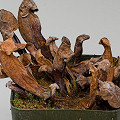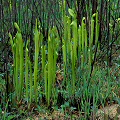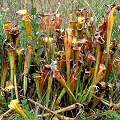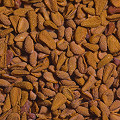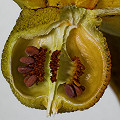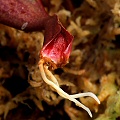Q: Sarracenia cultivation
A: Sarracenia are really not at all hard to cultivate, as
long as you follow The Rules. If you deviate from The Rules, Sarracenia
are either hard or impossible to grow. The most common
causes for death are inadequate lighting, incorrect soil or water, or inadequate winter treatment by growers in
tropical climates.
Sarracenia are pretty straightforward plants---if they are unhappy with your growing methods,
they die. There is very little lingering involved. So get it right, or you will have a soul stained with death.
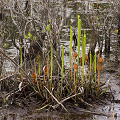 S. flava thrilled to
S. flava thrilled to
be wet and in sun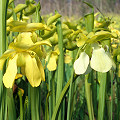 S. alata happy
S. alata happy
in full sun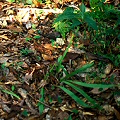 S. a. subsp. alabamensis
S. a. subsp. alabamensis
sick in dappled sun
Lighting: Sarracenia, especially the erect trumpet
species, require extremely high sun. This means
that they are not suited for terrarium culture. Simply put, do not try to grow erect
Sarracenia in terraria, indoors, or in partial to full shade as they will never get enough light. Symptoms of
insufficient lighting of your erect trumpet pitcher plants are pitchers that are floppy or poorly colored. The pitchers
should be able to support their own weight, although you can expect some floppy pitchers late in the season for
S. alata and S. rubra-complex plants.
The prostrate species---Sarracenia purpurea, S. psittacina, and
S. rosea---can survive and even thrive in lower lighting conditions such as you might expect in
a terrarium or windowsill. It is pretty obvious these shorter plants are adapted to the decreased sunlight they experience in the wild
because of competing, taller vegetation. If you want to try to grow Sarracenia in a terrarium, start with these
species or hybrids involving them. By the way, the seedlings of most species do well in terraria, until the seedlings are a few years
old.
Water: Stick with purified water. Keep the plants moist, sitting in
trays of water. A dried Sarracenia is a dead one.
Soil: Sarracenia are not too picky, as long as it is a zero-nutrient,
acid medium. I recommend 50:50 sand:peat or Sphagnum, but something similar should be fine.
Temperatures: Use something like weather.com to learn about the seasonal variations your plant
will expect. Use "Mobile, Alabama" to learn about Gulf Coast plants, and "Wilmington, North Carolina" to learn
about Green Swamp plants. If you have a Sarracenia purpurea from some northern area, I suspect
you already know what to do. The same goes for the rare Sarracenia species.
Winter treatment: Sarracenia expect spring, summer, fall,
and winter seasons. During the spring, they flower. During the summer, they produce their first
pitchers early in the season. During the fall, they just sit there; some species make modified,
nontrapping leaves during this season. During the winter, the remains of the
summer leaves slowly die back. I think winter rest is signalled by cooler temperatures and/or decreased
photoperiod/intensities, but I do not really know. You can take advantage of this slow season
by trimming the leaves back as they die. Only trim off the dead stuff---never cut into living tissue.
Sarracenia oreophila, S. jonesii, and
S. purpurea subsp.
purpurea expect cold weather and even frosts during the winter. If you keep your plants on a
seasonal schedule, they will usually flower for you each spring. This means they are happy!
Indoor growers have their own challenges with Sarracenia.
Sarracenia rosea and S. purpurea subsp. venosa
do well in terraria year-round without a winter treatment. However,
giving them one will encourage normal annual-rhythmic behaviour such as flowering. If you are growing other species in terraria,
such as S. purpurea subsp. purpurea, you should devise a way to give them the cold
period they expect. You may find some inspiration reviewing the
dormancy tricks I provide for Venus flytrap growers.
Feedings and fertilizers: Every now and then I will throw a dead cricket into one or two pitchers,
but only for the plants I grow in terraria. I never feed bugs to my outdoor plants because they capture plenty of their own bugs.
I even have heard from people who have to stuff cotton plugs in their pitcher plants' tubes because they capture so many bugs the
plants suffer!
Contrary to conventional wisdom, some research indicates that Sarracenia do respond well to
slow release soil fertilizers, although I encourage you to read the original study by Brittnacher (2009) to see how it
was done. I do not use fertilizers, nor do I recommend them to beginning growers.
My plants do great with the bugs they capture. If you kill your plants because
of fertilizer toxicity, complain to whoever told you to fertilize. Do not whine to me because I will show you no mercy.
Vegetative propagation: If your plants are growing so large that they are splitting open the
pot, you can divide them. This should happen only every three years or so. Of course, you can divide more frequently if you want to
send a plant out to a trading partner. Gently rip the plant into parts, making sure that each separate piece has a few roots and
a growing tip. Actually, it does not even need roots or a growing tip---a chunk of rhizome, potted and treated like a mature plant,
can make both roots and a new growing point, if you are a skillful grower.
Different growers have differing views on the best season for making divisions.
I prefer to do it in the spring, just when the first pitchers or flower buds reach a few cm tall. Expect that a plant that has
been divided might make distorted pitchers for the first year after suffering the abuse of propagation.
Sarracenia rosea, S. purpurea, and
S. psittacina can all be propagated by leaf pullings. Related hybrids can also probably be
propagated this way. I think other species could be propagated this way, but I have not figured out the details yet.
Sexual propagation: Sarracenia are easy to propagate this way.
You will have to transfer pollen from the anthers to the stigmatic surfaces. Do that well, and in the fall
you will have lots of seed. It takes Sarracenia plants
about 3-5 years to reach flowering size from seed,
although sometimes I hear of people beating this speed benchmark. Self-pollinating a plant can result in symptoms of inbreeding, such
as poor germination rates or slow growth. Cross pollinate plants to avoid this.
You might want to try cross pollinating plants to make hybrids, if that is your thing!
Page citations: Brittnacher, J. 2009;
D'Amato, P. 1998a; Rice, B.A. 2006a; personal observations.
